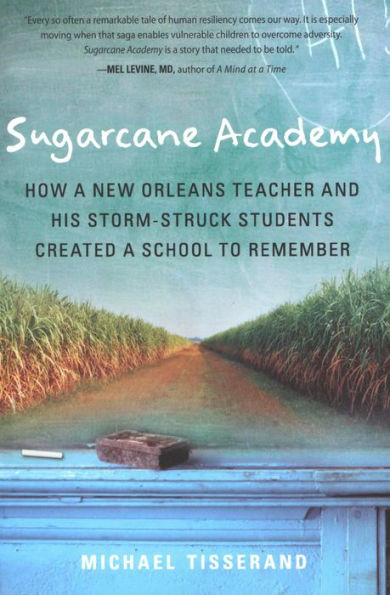This inspiring story of a post-Katrina classroom "reminds us all that heroes hold small hands on field trips, clean paint brushes, and sing morning songs" (Phillip Done, author of 32 Third Graders and One Class Bunny: Life Lessons from Teaching).
As floodwaters from Hurricane Katrina surged at their heels, those fleeing New Orleans had their minds more on safety than on whether their children would be missing school. But when a group of evacuee parents who settled in New Iberia, Louisiana, realized they would not be returning home quickly, they set about reconstructing their families' lives. And so they turned to beloved New Orleans schoolteacher Paul Reynaud, whose fierce determination and unwavering spirit transformed an abandoned office into a one-room schoolhouse. This is the story of Sugarcane Academy: twenty-five students, their devoted parents, an inspiring teacher, and the boundless power of learning.
"This wonderful memoir manages to do what a flood of news-reporting could not: see the tragedy of Katrina through the eyes of children. The story of the Sugarcane Academy, an improvised one-room school in a sugarcane parish in south Louisiana, will be one of the lasting books of our tragedy." —Andrei Codrescu, author of New Orleans, Mon Amour: Twenty Years of Writings from the City
1100303710
As floodwaters from Hurricane Katrina surged at their heels, those fleeing New Orleans had their minds more on safety than on whether their children would be missing school. But when a group of evacuee parents who settled in New Iberia, Louisiana, realized they would not be returning home quickly, they set about reconstructing their families' lives. And so they turned to beloved New Orleans schoolteacher Paul Reynaud, whose fierce determination and unwavering spirit transformed an abandoned office into a one-room schoolhouse. This is the story of Sugarcane Academy: twenty-five students, their devoted parents, an inspiring teacher, and the boundless power of learning.
"This wonderful memoir manages to do what a flood of news-reporting could not: see the tragedy of Katrina through the eyes of children. The story of the Sugarcane Academy, an improvised one-room school in a sugarcane parish in south Louisiana, will be one of the lasting books of our tragedy." —Andrei Codrescu, author of New Orleans, Mon Amour: Twenty Years of Writings from the City
Sugarcane Academy: How a New Orleans Teacher and His Storm-Struck Students Created a School to Remember
This inspiring story of a post-Katrina classroom "reminds us all that heroes hold small hands on field trips, clean paint brushes, and sing morning songs" (Phillip Done, author of 32 Third Graders and One Class Bunny: Life Lessons from Teaching).
As floodwaters from Hurricane Katrina surged at their heels, those fleeing New Orleans had their minds more on safety than on whether their children would be missing school. But when a group of evacuee parents who settled in New Iberia, Louisiana, realized they would not be returning home quickly, they set about reconstructing their families' lives. And so they turned to beloved New Orleans schoolteacher Paul Reynaud, whose fierce determination and unwavering spirit transformed an abandoned office into a one-room schoolhouse. This is the story of Sugarcane Academy: twenty-five students, their devoted parents, an inspiring teacher, and the boundless power of learning.
"This wonderful memoir manages to do what a flood of news-reporting could not: see the tragedy of Katrina through the eyes of children. The story of the Sugarcane Academy, an improvised one-room school in a sugarcane parish in south Louisiana, will be one of the lasting books of our tragedy." —Andrei Codrescu, author of New Orleans, Mon Amour: Twenty Years of Writings from the City
As floodwaters from Hurricane Katrina surged at their heels, those fleeing New Orleans had their minds more on safety than on whether their children would be missing school. But when a group of evacuee parents who settled in New Iberia, Louisiana, realized they would not be returning home quickly, they set about reconstructing their families' lives. And so they turned to beloved New Orleans schoolteacher Paul Reynaud, whose fierce determination and unwavering spirit transformed an abandoned office into a one-room schoolhouse. This is the story of Sugarcane Academy: twenty-five students, their devoted parents, an inspiring teacher, and the boundless power of learning.
"This wonderful memoir manages to do what a flood of news-reporting could not: see the tragedy of Katrina through the eyes of children. The story of the Sugarcane Academy, an improvised one-room school in a sugarcane parish in south Louisiana, will be one of the lasting books of our tragedy." —Andrei Codrescu, author of New Orleans, Mon Amour: Twenty Years of Writings from the City
14.99
In Stock
5
1

Sugarcane Academy: How a New Orleans Teacher and His Storm-Struck Students Created a School to Remember
192
Sugarcane Academy: How a New Orleans Teacher and His Storm-Struck Students Created a School to Remember
192Related collections and offers
14.99
In Stock

Product Details
| ISBN-13: | 9780547350714 |
|---|---|
| Publisher: | HarperCollins |
| Publication date: | 06/01/2018 |
| Sold by: | Barnes & Noble |
| Format: | eBook |
| Pages: | 192 |
| File size: | 1 MB |
About the Author
What People are Saying About This
From the B&N Reads Blog
